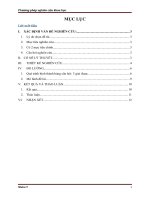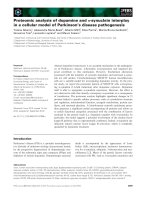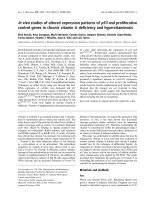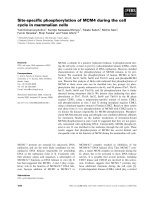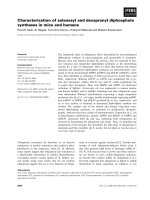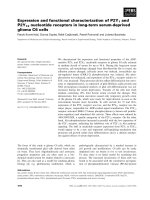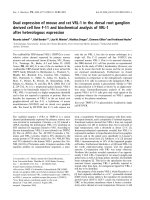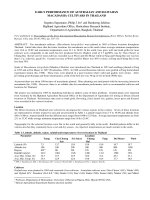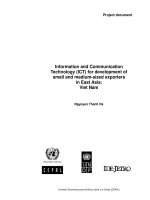Auditing of sales and account receivables cycle in financial statement auditing, by avn vietnam audit company limited in da nang for abc company
Bạn đang xem bản rút gọn của tài liệu. Xem và tải ngay bản đầy đủ của tài liệu tại đây (13.83 MB, 127 trang )
DUY TAN UNIVERSITY
INTERNATIONAL SCHOOL
---------------------------
UNDERGRADUATE THESIS
AUDITING OF SALES AND ACCOUNT RECEIVABLES CYCLE IN
FINANCIAL STATEMENT AUDITING, BY AVN VIETNAM AUDIT
COMPANY LIMITED IN DA NANG FOR ABC COMPANY
Mentor
: Masters Vo Thi Thuy Linh
Student
:
Nguyen Thi Hong Nhung
Class
:
K25 PSU KKT1
Student code:
:
25202510246
DA NANG - 2023
ABSTRACT
DISCLAIMER
ACKNOWLEDGEMENTS
LIST OF ABBREVIATIONS
LIST OF FIGURES
INTRODUCTION.......................................................................................................1
CHAPTER 1: LITERATURE REVIEW OF SALES AND ACCOUNT
RECEIVABLES CYCLE AUDIT IN FINANCIAL STATEMENTS AUDITING 3
1.1 GENERAL OVERVIEW OF SALES AND ACCOUNT RECEIVABLES
CYCLE..................................................................................................................... 3
1.1.1 Concept, characteristics and of Sales and Account Receivables Cycle...3
1.1.1.1
Concept and recognition principles of Sales.......................................5
1.1.1.2. Concepts and recognition principles of Account Receivables...............5
1.1.2 Accounting for Sales and Account Receivables Cycle..............................6
1.1.2.1 Vouchers................................................................................................7
1.1.2.2 Detail accounting...................................................................................7
1.1.2.3 General accounting................................................................................7
1.2 AUDITING ISSUES OF SALES AND ACCOUNT RECEIVABLES
CYCLE AUDIT IN FINANCIAL STATEMENTS AUDITING..........................9
1.2.1 Objective of Sales and Account Receivables Cycle Audit........................9
1.2.1.1 Audit objective of Sales.........................................................................9
1.2.1.2 Audit objective of Account Receivables................................................9
1.2.2 Internal control system in Sales and Account Receivables Cycle Audit
............................................................................................................................. 10
1.2.2.1 Internal control system in Sales............................................................10
1.2.2.2 Internal control system in Account Receivables...................................11
1.2.3 Risk of Sales and Account Receivables Cycle Audit...............................11
1.3 AUDITING OF SALES AND ACCOUNT RECEIVABLES CYCLE.........12
1.3.1 Audit planning...........................................................................................12
1.3.1.1 Prepare for an auditing plan.................................................................13
1.3.1.2 Collecting information about the entity being audited.........................15
1.3.1.3 Perform preliminary analytical procedures..........................................16
1.3.1.4 Preliminary assessment of internal control system...............................17
1.3.1.5 Assessment of materiality and auditing risks.......................................17
1.3.1.6 Summary of audit planning..................................................................19
1.3.2 Audit implementation stage......................................................................20
1.3.2.1 Control test...........................................................................................20
1.3.2.2 Basic test..............................................................................................20
1.3.3 Detail check...............................................................................................20
1.3.3.1 Detail check of Sales............................................................................20
1.3.3.2 Detail check of Account Receivables...................................................21
1.3.3.3 Check Allowance for doubtful Account Receivables...........................23
1.3.4 Audit ending..............................................................................................24
CHAPTER 2: METHODOLOGY OF SALES AND ACCOUNT RECEIVABLES
CYCLE AUDIT IN FINANCIAL STATEMENTS AUDITING, BY AVN
VIETNAM AUDIT COMPANY LIMITED FOR ABC COMPANY....................25
2.1 GENERAL OVERVIEW OF BUSINESS OPERATIONS OF THE AVN
VIET NAM AUDITING LIMITED COMPANY................................................25
2.1.1 History and development of the company AVN.....................................25
2.1.2 Organizational structure in company......................................................25
2.1.3 The main types services of company........................................................26
2.1.3.1 Auditing services..................................................................................26
2.1.3.2 Accounting services.............................................................................27
2.1.3.3 Tax consulting services........................................................................27
2.1.3.4 Finance consulting services..................................................................28
2.1.4 Operating principles and target of company..........................................28
2.1.4.1 Operating principles.............................................................................28
2.1.4.2 Target of operating...............................................................................28
2.2 THE REALITY OF THE AUDIT OF THE SALES AND COLLECTION
CYCLE IN FINANCIAL AUDIT OF AVN VIET NAM AUDITING LIMITED
COMPANY OF CUSTOMER ABC.....................................................................29
2.2.1 Auditing plan.............................................................................................29
2.2.1.1 Considers to accept customer and valuation risk contract....................29
2.2.1.2 Audit contract.......................................................................................29
2.2.1.3 Find out customer and operating environment.....................................31
2.2.1.4 Learn the sales cycle, receivables, collection.......................................31
2.2.1.5 Preliminary analysis of financial statement..........................................33
2.2.1.6 General valuation about internal control system of customer...............33
2.2.1.7 Identify quantitative of materiality.......................................................33
2.2.1.8 Summary the audit planning................................................................33
2.2.2 Auditing implement..................................................................................34
2.2.2.1
Sales..................................................................................................34
2.2.2.2
Account receivables..........................................................................37
2.2.3 Audit ending..............................................................................................39
CHAPTER 3: SOLUTIONS TO COMPLETE THE AUDIT OF THE SALE AND
COLLECTION CYCLE IN AUDIT OF FINANCIAL STATEMENTS AT AVN
VIETNAM AUDIT COMPANY LIMITED............................................................41
3.1 GENERAL ASSESSMENT OF THE AUDITING PROCESS SELLING AND
COLLECTION CYCLE PROCESS AT ABC COMPANY BY AVN....................41
3.1.1 Advantage...................................................................................................41
3.1.2 Disadvantages.............................................................................................42
3.2 COMPLETE SOLUTION OF SALES AND ACCOUNT RECEIVABLES
CYCLE AUDIT IN FINANCIAL STATEMENTS AUDITING PERFORMED BY
AVN VIETNAM AUDIT COMPANY LIMITED IMPLEMENTATION..............42
3.2.1 Completion of analytical procedure............................................................42
3.2.2 Analytical procedure of sales......................................................................43
3.2.3 Analytical procedure of Account receivables..............................................43
CONCLUSION...........................................................................................................44
REFERENCES
APPENDIX
ABSTRACT
Today, society is developing more and more, the diversification of operating models as
well as arising transactions are increasingly complex, leading to the birth of audit
activities, especially independent audits.
In the business investment strategy, the investor always focuses on the financial
situation and the provision for doubtful receivables through both the items
Receivables, Sales and Fees on the Statement. finance. Therefore, the decrease in
receivables shows that the cost of bad debts is increasing and taking up capital of the
company.
Stemming from the importance of the audit system in general and the sales cycle audit
and receivables in particular, by specific qualitative research methods, I will describe
the sales cycle audit process goods and receivables at AVN Viet Nam Auditing Co.,
Ltd. implemented and proposed some solutions to complete this process.
DISCLAIMER
I certify that the attached thesis is my original work. No other person's work has been
used without due acknowledgement. Except where I have I clearly stated that I have
used some of the this material, it has not been presented by me for examination in any
other course or subject at this or any other institution. I understand that the work
submitted may be reproduced and/or communicated for the purpose of detecting
plagiarism. I understand that should this declaration be false. I am libel to be penalized
under the Duy Tan University regulations.
ACKNOWLEDGEMENTS
During my internship at AVN Viet Nam Auditing Company Limited in Da Nang and
pursuing my studies at the Faculty of International Affairs - Duy Tan University, this
was a real opportunity to help me broaden my horizons in the field of auditing and
accounting.
First of all, I would like to sincerely thank the dedicated guidance of the teachers,
especially the guidance of Master, Lecturer Vo Thi Thuy Linh of the International
Faculty - Duy Tan University, and the Department of Auditing. of AVN Viet Nam
Auditing Company Limited gave me the best conditions to complete the thesis
quickly.
Furthermore, I look forward to receiving your suggestions and guidance so that I can
do my job well in the future with my inexperience.
Once again, I would like to thank the teachers of the Department of International
Affairs - Duy Tan University, especially the dedicated guidance of Master, Lecturer
Vo Thi Thuy Linh, and the Audit Department of Co., Ltd. AVN Viet Nam Auditing in
Da Nang helped me complete my internship and graduate thesis.
Best wishes to all of you. Best regards!
AVN
BTC
TT
VACPA
LIST OF ABBREVIATIONS
AVN Viet Nam Auditing Co., Ltd
Exchequer
Circular
Vietnam Asociation of Certified Public Accountans
LIST OF FIGURES
Diagram 1- 1 Accounting for Sales.............................................................................8
Diagram 1- 2 Accounting for Account Receivables...................................................9
Diagram 2- 1 Organizational structure of AVN Viet Nam Audit at Branch Đa
Nang............................................................................................................................ 26
INTRODUCTION
1. Reason for choosing the topic
Sales and Account Receivables Cycle is the last stage in an enterprise's
production and business cycle, this cycle not only evaluates the effectiveness of the
previous cycles but also reflects the effectiveness of the entire export operation
process business and financial position of enterprise. The result of this stage is
done through the important items of nature required on the financial statements,
auditors must carefully find these items to give a definite look for financial
statements user.
Therefore, auditing the Sales and Receivables cycle has a very clear meaning,
helping the audit department and the enterprise to recognize the weaknesses and
errors in the accounting and management work, from which the enterprise can
improve and improve production and business efficiency. In addition, if done well
Auditing the sales cycle and accounts receivable can help the audit department save
time and reduce audit costs. Realizing the importance of the problem, during my
study at the Faculty of International Affairs - Duy Tan University and the
internship period at AVN Viet Nam Auditing Co., Ltd in Da Nang, I chose the
topic "Auditing Cycle sales and receivables in the Audit of Financial Statements,
by AVN Viet Nam Auditing Company Limited in Da Nang for ABC Company”.
2. Research objective
- Systematize a number of theoretical issues on Sales and Account Receivables
Cycle Audit.
- Learn the current status of Sales and Account Receivables at ABC Company.
- On the literature review and practical research, compare and evaluate the
advantages and disadvantages of Sales and Account Receivables Cycle at ABC
Company. From there, propose solutions to improve and improve the efficiency of
Sales and Account Receivables Cycle at ABC Company.
3. Research subject and method Research subject
Research subject
System of Sales and Account Receivables Cycle
Specific qualitative research methods
- Vouchers research method: refer to Vietnamese accounting standards, auditing
standards, audit textbooks, etc., to form the basis for forming a theoretical basis for
Sales and Account Receivables Cycle as well as a foundation to learn the actual
Sales and Account Receivables Cycle at the unit.
- Direct interview method: conduct direct interviews with officials and employees
at the financial accounting department, sales department, especially those who
provide information and data related to the topic. The face-to-face interview helps
answer questions in the process of accessing information at the unit. Thanks to that,
we get an overview of ABC Company, thereby helping to implement the topic
well.
- Observation method: implemented during the internship at the unit by observing
the employees in charge of the fields in the organization. units, thereby
accumulating knowledge and experience.
- Data collection method:
+ Secondary data: collected from available sources inside the entity such as
financial statements, books, vouchers...; from media such as newspapers,
magazines, internet, website.
+ Primary data: collected from observation, interviewing officials and employees at
the unit.
- Methods of processing, analyzing and comparing data: processing the raw data
provided by the unit, comparing and contrasting data between years, the increase
and decrease of the indicators. From there, the position, growth rate and decrease
can be determined and comments on those changes can be drawn at the unit.
- Method of synthesis and evaluation: from collected information and data
combined with the process of observing Sales and Account Receivables Cycle at
the unit to make judgments, evaluate the advantages and disadvantages, find out
the causes and then propose solutions.
4. Research scale
-Time: research topic on the basis of information and data in 2022
-Spatial: research topic within the company, focusing mainly on the financeaccounting department.
-Content: the topic focuses on Auditing of Sales and Account Receivables Cycle
5. Topic structure
Chapter 1: Literature review of Sales and Account Receivables Cycle Audit in
Financial Statements Auditing
Chapter 2: Methodology of Sales and Account Receivables Cycle Audit in
Financial Statements Auditing, by AVN Viet Nam Auditing Co., Ltd in Da Nang
for ABC Company
Chapter 3: Complete solution of Sales and Account Receivables Cycle Audit in
Financial Statements Auditing, by AVN Viet Nam Auditing Co., Ltd in Da Nang
for ABC Company
CHAPTER 1: LITERATURE REVIEW OF SALES AND ACCOUNT
RECEIVABLES CYCLE AUDIT IN FINANCIAL STATEMENTS AUDITING
1.1 GENERAL OVERVIEW OF SALES AND ACCOUNT RECEIVABLES
CYCLE
1.1.1 Concept, characteristics and of Sales and Account Receivables Cycle
Concept
Sales and Account Receivables Cycle includes the decisions and processes required
to transfer ownership of goods and services to the customer when we are ready to sell.
The cycle begins with a customer order and ends with the conversion of a material or
service to an account receivables, and finally to cash. (Finance, Circular 200/2014/TTBTC, 2014)
Main functions of the sales and account receivable cycle
Most businesses, Sales and Account Receivables Cycle usually have functions such
as: receiving and processing customer orders customer, approve credit, deliver goods,
invoice customer and record revenue, process and book receivables, process and
record returned and reduced sales prices, write off uncollectible receivables, provision
for doubtful debts.
Receiving and processing customer order: this is the first stage of the cycle.
Customer requests an order and ready to buy it in a particular way. As soon as the
order is received, it is very important to check the order because it does not exclude
the possibility that the order is fake or has a fraudulent item. On the basis of the
confirmed order, the order is moved to the processing stage to make a sales decision
and apply a selling price to the order.
Approving the credit method: before transferring goods or services to the customer,
the authorized person must agree with the method of sale on credit to the customer.
The responsible person must consider the solvency and credit limit of the customer to
minimize bad debts. For most businesses, agreeing to ratify this method means
agreeing to the transfer of goods.
Goods transfer: This function marks the transfer of assets and goods of the
enterprise to the customer and the transfer of ownership to the customer and is the
basis for recording revenue. Shipping documents are made at the time of shipment and
must match the actual quantity shipped and the quantity on the contract. And these
vouchers assist in keeping track of the business's inventory.
Send invoices to customers and record revenue: the accounting department is
responsible for making and sending sales invoices to customers, recording revenue.
Thereby, customers can know information about the amount owed toto of goods and
payment limit. And it is important that the invoice sent out matches the quantity of the
goods sent and is correct with the price (including the price of the goods, freight,
insurance and form of payment).
Managing and recording cash receipts: to ensure that accounts receivable are
recorded accurately and on time. If the customer pays by cash or bank deposit, the
accountant records it in the cash receipts journal. If the customer has not paid, it will
be reflected in account 131 -Account Receivables, followed up on the debt details
book for each customer.
Handling and recording sales returns and allowances or sales discounts: when
receiving goods, customers find that the goods are defective or do not meet the
requirements, sellers often tend to accept returned goods or give a refund discount. In
that case, sales from returned or discounted merchandise should be recorded accurately
and promptly in the returned or discounted sales journal as well as in the subsidiary
ledger.
Allowance for Doubtful Account Receivables: before closing the books and
preparing financial statements, enterprises must estimate and make provisions for
uncollectible amounts in the present and in the future. (Arens, Auditing+ Assurance
Services, 2019).
Under the allowance method, a company records an adjusting entry at the end of
each accounting period for the amount of the losses it anticipates as the result of
extending credit to its customers.
Provision level (Finance, Circular 48/2019/TT-BTC, 2019)
Pursuant to Article 6 of Circular 48/2019/TT-BTC dated 08/08/2019 stipulating:
a) For overdue Account receivables, the level of provision is as follows:
30%
50%
70%
100%
Account receivables that are overdue from 6 months to less
than 1 year
Account receivables that are overdue from 1 year to less than 2
years
Account receivables that are overdue from 2 year to less than 3
years
Account receivables from 3 years or more
b) For telecommunications service businesses and goods retail businesses, the
receivables from telecommunications, information technology, and postpaid television
services and receivables from retail sales Deferred payment/installment payment of
individual debtors overdue for payment of the provision is as follows:
30%
50%
70%
100%
Account receivables that are overdue from 3 to less than 6
months
Account receivables that are overdue from 6 to less than 9
months
Account receivables that are overdue from 9 to less than 12
months
Account receivables from 12 months or more
1.1.1.1Concept and recognition principles of Sales
Concept
According to Article 78 of Circular200, Sales is the part of economic benefits
obtained that increases the equity of the enterprise, excluding more contribution from
shareholders. Revenue is recognized as soon as the transaction takes place and it is
certain that economic benefits will be generated. In addition, revenue is also
determined according to the fair value of the amounts entitled to receive, regardless of
whether the money has been collected or not. (Finance, Circular 200/2014/TT-BTC,
2014)
Recognition principles of Sales
Circular 200/2014/TT-BTC in Article 78 stipulates accounting principles for
account 511 –Service and Fee revenue. (Finance, Circular 200/2014/TT-BTC, 2014)
Revenues and expenses that generate revenues are subject to the matching
principle. But sometimes the principle of concordance in accounting will be
contradicted with the principle of prudence. At this time, accounting needs to be based
on the nature to be able to determine the most accurate and reasonable transactions.
Revenue profit or loss only undetermined. When the enterprise is still
responsible for the performance of future obligations. (Except for the most basic
warranty obligations). And certainly not yet reap the economic benefits. The
classification of losses or gains does not depend on whether cash flows have been
incurred.
Revenue does not include third-party receipts:
- Types of indirect substitution (VAT, environmental protection tax, export tax,
special consumption tax)
- Amount of money collected by the sales agent for the main owner
- Concessions outside the unit selling price are not entitled to or otherwise.
The timing for recognizing accounting revenue andtax revenue may vary from
case to case. Tax revenue is used to determine the tax payable according to
regulations. The accounting revenue used to prepare the financial statements must
strictly comply with the regulations. And depending on the case, it is not necessary to
match the number stated on the sales invoice.
When transferring goods or services between internal accounting units.
Depending on the locations and operating characteristics, the enterprise may decide to
recognize revenue at the units. If there is an increase in the value of the product
without having to follow the accompanying documents. When preparing the financial
statements, all transactions between internal entities must be eliminated.
Revenue is recognized when the revenue for the period is reported. Accounts
that do not have a balance, at the end of the accounting period, must transfer revenue
to get the most accurate business results.
1.1.1.2. Concepts and recognition principles of Account Receivables
Concept of Account receivables
According to Article 17 of Circular 200: Account Receivables are receivables in
cash and cash equivalent that an enterprise will receive from providing goods and
services to customers. Customers are entities or individuals outside the business.
Recognition principles of Account Receivables
Circular 200/2014/TT-BTC in Article 17 stipulates accounting principles for
account 131 – Account Receivables.
Receivables are tracked in detail according to the receivable period, receivable
object, type of receivable currency and other factors according to the management
needs of the enterprise.
The classification of receivables as receivables from customers, internal
receivables and other receivables is done according to the following principles:
- Receivables from customers include receivables of commercial nature arising
from transactions of the nature of purchase and sale, such as: Receivables from sales,
service provision, liquidation and sale of assets (Fixed assets, investment properties,
financial investments) between the enterprise and the buyer (an entity independent of
the seller, including receivables between the parent company and its subsidiaries, joint
ventures and associates). This receivable includes receivables from export sales of the
entrusting party through the trustee;
- Internal receivables include receivables between superior units and subordinate
units without legal status, dependent accounting;
- Other receivables include receivables of non-commercial nature, unrelated to
purchase -sale transactions, such as:
Receivables that generate revenue from financial activities, such as: receivables
from loan interests, deposits, dividends and distributed profits;
Payments on behalf of third parties are entitled to receive back; Amounts that the
entrusting party must collect on behalf of the entrusting party;
Non-commercial receivables such as property loans, fines, compensation, pending
assets...
When making financial statements, accountants base on the remaining term of
receivables to classify as long-term or short-term. Receivables items of the Balance
Sheet may include amounts reflected in accounts other than accounts receivable, such
as: Loans are recorded in Account 1283; Deposits and deposits are reflected in
Account 244, advance in Account 141... The determination of provisions for doubtful
receivables is based on items classified as short-term and long-term receivables of the
Balance Sheet.
Accountants must determine receivables that satisfy the definition of monetary
items denominated in foreign currencies (detailed in account 413 –Exchange rate
differences) for re-evaluation at the end of the period when financial statements.
1.1.2 Accounting for Sales and Account Receivables Cycle.
Classifying transactions and identifying related transactions
Auditors can understand the relationship between the activities in the enterprise as
well as identify the related items in the transactions cycle in general and Sales and
Account Receivables Cycle in particular will help auditors to perform auditing with
high efficiency.
Sales and Account Receivables Cycle is usually divided into two types of
transactions: Sales and Account Receivables.
The related items in this cycle usually include:
On income statement: Service revenue and Fee revenue, items that show a
deduction for sales such as Sales discounts, Sales returns and allowances
On balance sheet: Accounts receivables and Cash and cash equivalent.
Other related items that can be used in the audit process such as: Cost of goods
sold, Inventory and Sales expenses,
1.1.2.1 Vouchers
Types of vouchers used to account for transactions in Sales and Account
Receivables Cycle usually include
Economic contracts for the supply of goods and services
Purchase orders.
VAT invoice.
Liquidation minutes of economic contracts.
Settlement minutes of goods and services provision.
Receipt vouchers, Bank Credit Note, Bank statement or supplementary book.
Vouchers related to transportation of finished products and goods.
1.1.2.2 Detail accounting
The main accounting books include: Detailed book of Sales and Fee revenue
(511...) and Detailed book of Account Receivables (131)
1.1.2.3 General accounting
The Main accounting books include: General book of Sales and Fee revenue (511...)
and General book of Account Receivables (131)
Account 511 (Finance, Circular 200/2014/TT-BTC, 2014)
Debit
Credit
- Indirect taxes payable (VAT, SCT,
Revenue from sale of products, goods,
export, environmental protection);
investment real estate and provision of
- Sales returns and allowances are services by the enterprise during the
carried forward at the end of the period; accounting period.
-Sale discounts transferred at the end
of the period;
- Trade discount carried forward at the
end of the period;
- Transfer net revenue to account 911
"Income Summary".
No ending balance
Account 131 (Finance, Circular 200/2014/TT-BTC, 2014)
Debit
- Amounts
receivable
from
customers
for
products,
goods,
investment properties, delivered fixed
assets, and services provided and
determined to be sold during the period;
- The excess amount returned to the
customer
Ending balance
Amounts of Account receivables
Credit
- Amount of debt the customer has
paid;
- Amount received in advance,
prepaid by customers;
- Discounts on goods sold to
customers after delivery and customer
complaints;
- Turnover of sold goods returned
by buyers (with or without VAT);
- Amount of payment discount and
trade discount for the buyer.
The amount received in advance, or
the amount collected is more than the
amount receivable from customers,
detailed by each specific object.
Overview chart of account for Sales and Account Receivables Cycle
Diagram 1- 1 Accounting for Sales
Diagram 1- 2 Accounting for Account Receivables
1.2 AUDITING ISSUES OF SALES AND ACCOUNT RECEIVABLES CYCLE
AUDIT IN FINANCIAL STATEMENTS AUDITING.
1.2.1 Objective of Sales and Account Receivables Cycle Audit
1.2.1.1 Audit objective of Sales
General
audit
Audit objective of Sales
objective
Occurrence
Goods shipped to customers, services delivered to
customers are real
Completeness
All sales transaction are recorded
Classification
Sales transactions are properly classified
Accuracy
Sales transactions are recorded in the appropriate
detailed and general ledgers and must match in terms of
data, exactly in the amount added
Valuation
Goods shipped, services performed with sales invoices
1.2.1.2 Audit objective of Account Receivables
General
audit
Audit objective of Account receivables
objective
Occurrence
All receivables are recorded to reflect reality
Completeness
All account receivables are recorded
Classification
Receipts are properly classified
Accuracy
The receivables are calculated correctly
Valuation
The cash receivables are properly assessed (related
transactions) to foreign currencies must be converted
according to regulations)
1.2.2 Internal control system in Sales and Account Receivables Cycle Audit
1.2.2.1 Internal control system in Sales
❖ Synchronization of accounting books
Requires the accounting system from accounting vouchers, accounting books to the
accounting summary sheet to have maximum control over transactions and therefore,
accounting procedures must be in place before setting internal control objectives. Each
unit can choose accounting forms, different accounting methods lead to different
specific accounting procedures. Each entity needs to specify a specific sequence
corresponding to the bookkeeping system that constitutes an effective control element.
❖ Numbering of vouchers
Using pre-numbered vouchers in continuous order has the effect of preventing
omission, concealment and duplication of sales transactions. The pre-numbering of
vouchers must have a clear purpose accompanied by a reasonable organization in a
positive direction to achieve that purpose.
❖ Monthly report
Normally, businesses make a summary and balance between goods sold and
receivables, accounts receivable to control Sales and Account Receivables and send it
to customers to confirm economic transactions. born in the month and in the period.
To ensure objectivity in the confirmation, these balance sheets can be assigned to
unrelated people (to Account Receivables, to book Sales and Account Receivables) to
prepare and send by post to buyers easy to answer even if there are mistakes.
❖ Approval of sales operations
This is a common internal control and focuses on three main points:
Credit sales must be approved prior to the sale of goods.
Sale goods are only shipped after approval with sufficient evidence (account,
seal, legal signature of the buyer).
The selling price must be approved including shipping costs, discounts and
payment terms.
The first two controls are intended to prevent loss due to shipping to "ghost" buyers
or buyers who are unable to pay or interfere in payment. The price review aims to
avoid loss of revenue, adequately stimulate revenue growth, and legally and
effectively settle the relationship of interests between the parties in the purchase-sale
relationship.
❖ Division of responsibilities
This is an important job in internal control to prevent mistakes in accounting in
general and in the field of Sales and Account Receivables in particular.
❖ Independence of testers and controllers in the implementation of internal
control
